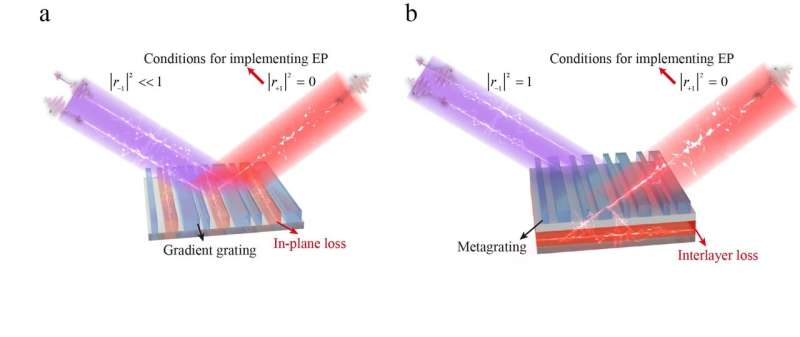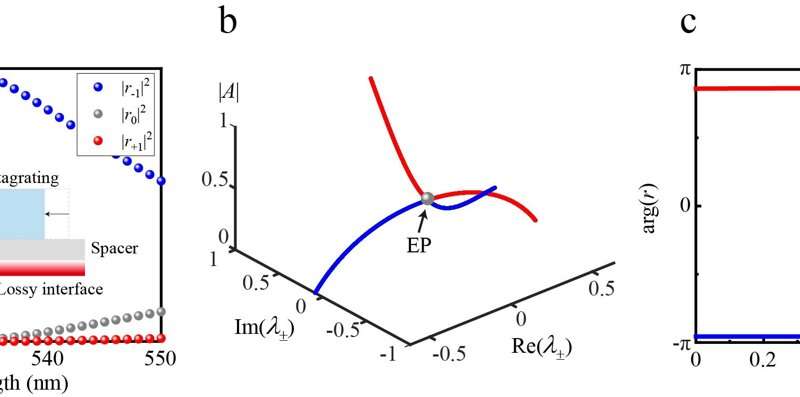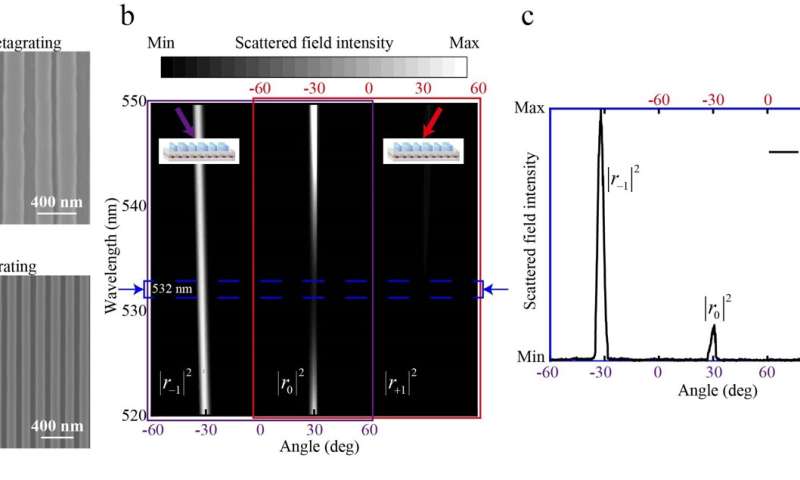This article has been reviewed according to Science X's editorial process and policies. Editors have highlighted the following attributes while ensuring the content's credibility:
fact-checked
peer-reviewed publication
trusted source
proofread
Study paves the way for new class of nanoscale devices, new opportunities in photonics

Non-Hermitian systems have numerous alluring optical properties at exceptional points (EPs) and have attracted extensive attention because of their great prospects in applications such as optical sensing, integrated optics, and other fields.
Recently, metasurface, a class of artificial materials that transcends natural materials through the orderly design of subwavelength structures, has become a new platform to realize complex optical EPs.
A common way to implement scattering EP in the acoustic/microwave range is regulating the loss of the gradient metasurfaces by introducing a specific loss in a unit cell. However, direct extensions of in-plane loss in a gradient metasurface from non-visible waveband to visible light remain a formidable challenge, since the adjustable in-plane loss and corresponding manufacturing process in the visible are lacking.
Furthermore, the complex and rebellious interplay between in-plane lossy structure and lightwave restricts optical efficiency. Therefore, achieving high-efficiency EP at optical non-Hermitian metasurface is still a challenging task in photonics. Notably, two-dimensional scattering systems operating at EPs in the visible are unexplored.
In a paper published in Light: Science & Applications, a team of scientists, led by Professor Cheng-Wei Qiu from Department of Electrical and Computer Engineering, National University of Singapore, Singapore and Xinbin Cheng from Institute of Precision Optical Engineering, School of Physics Science and Engineering, Tongji University, Shanghai, and co-workers have reported a universal paradigm for achieving a high-efficiency EP in the visible by leveraging interlayer loss to accurately control the interplay between the lossy structure and scattering lightwaves.
A bilayer framework is demonstrated to reflect back the incident light from the left side (|r-1| > 0.999) and absorb the incident light from the right side (|r+1| < 10-4).
"As a proof of concept, a bilayer metasurface composed of TiO2 metagrating and Si subwavelength grating is designed: the metagrating in the upper layer achieves the directional regulation of lightwave, and the lossy subwavelength grating in the lower layer achieves an adjustable absorption."
"When the proper absorption of Si subwavelength grating is selected, a wave vector-dependent perfect retroreflector and absorber is realized (Fig. 2a). The eigenvalues and phase change all proves that we have reached the EP (Fig. 2b and 2c)."
-

Fig 2. a, The spectra and schematics of the high-efficiency optical non-Hermitian meta-system at EP. The |r₋₁| is larger than 0.999 and |r₊₁| is less than 10⁻⁴. b, Trajectories of eigenvalues with the evolution of absorption parameter. c, The amplitude of non-specular reflection coefficients r₋₁ and r₊₁ by varying absorption parameter. Credit: Tao He, Zhanyi Zhang, Jingyuan Zhu, Yuzhi Shi, Zhipeng Li, Heng Wei, Zeyong Wei, Yong Li, Zhanshan Wang, Cheng-Wei Qiu, Xinbin Cheng -

Fig 3. a, Top view and back view of the sample. The upper layer is TiO2 metagrating and the lower layer is Si grating. b, The far-field scattered light from all angles of the sample with incident angles of 30° and -30°. c, The experimental measured far-field scattered light from all angles with incident angles of 30° and -30° at 532 nm. Credit: Tao He, Zhanyi Zhang, Jingyuan Zhu, Yuzhi Shi, Zhipeng Li, Heng Wei, Zeyong Wei, Yong Li, Zhanshan Wang, Cheng-Wei Qiu, Xinbin Cheng
"We fabricated the sample (Fig. 3a) and conducted two separate tests with incident angles of 30° and −30° as shown in the purple and red boxes of Fig. 3b. When the incident light impacted from the left, most of the light was reflected by the sample to the incident path. When the incident light came from the right, there was very little retroreflection light. The fabricated sample is experimentally demonstrated to reflect and absorb incident light with efficiencies of 88% and 85%, respectively, at 532 nm. (Fig. 3c)."
"Our work paves a new avenue toward the design of versatile optical metasurface platforms involving the EP or higher-order EP, which may inspire more functional photonic devices for wave manipulation," the scientists say.
More information: Tao He et al, Scattering exceptional point in the visible, Light: Science & Applications (2023). DOI: 10.1038/s41377-023-01282-4
Journal information: Light: Science & Applications
Provided by Chinese Academy of Sciences




















